By Jeffrey A. Rendall, Photos By Kevin Gaydosh
KIAWAH ISLAND, SC – Everybody’s done it – something in life that you knew was a mistake at the time, yet did it anyway, and regretted it for years.
If only we could relive the past, plaster over the blunder, and re-write history – it’d be life’s grandest mulligan.
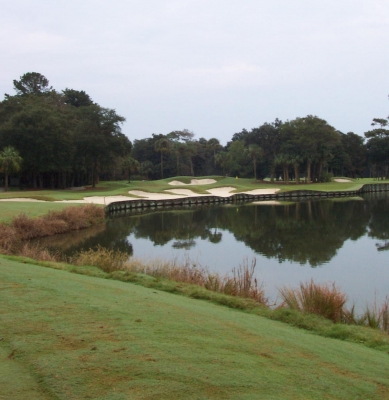 |
| Cougar Point's par three 2nd hole is the first you'll see when you enter the resort -- and it's not a bad view, either. |
In the case of Kiawah Island Golf Resort’s Cougar Point Golf Course, there was such a ‘second chance,’ and its golf architect, Gary Player, ran with it.
Tim Freeland, Player’s project architect at Cougar Point for the renovation (which took place in 1995-96), tells the tale: “The original layout that became Cougar Point was built in the 1970’s (its original name was Marsh Point), and there were some problems with it from the start. It wasn’t really an executive course, but it wasn’t really a championship course either.”
Freeland continues, “And it seemed as if, in order to make up for its lack of length, the original design team made the greens more difficult and tightened up the fairways a little bit, trying to keep the challenge level up a bit higher. What you ended up with was a course that looked easy on the scorecard, and appeared relatively easy from tee to green, but actually played very difficult. With its tiny, elevated greens with too much undulation, the course was next to impossible to get up and down.”
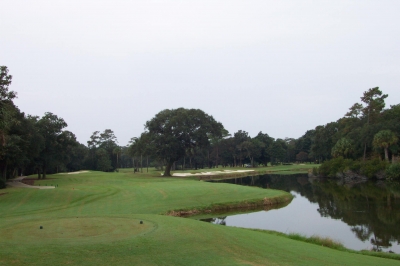 |
| The dogleg right, par four 17th hole (363 yards) features a huge oak to the right of the short landing area. Big hitters can try to blast it over the tree, or draw it around it if you dare. |
It wasn’t really Player’s fault, either, since the original ownership group changed the parameters of the course during construction, including how much land was available for golf.
Marsh Point was everything that Gary Player didn’t want in a course, one that looks easy but played difficult. Player’s one of history’s legendary golfers, having mastered his craft and won all four major championships on some of golf’s most difficult courses – but when it comes to designing for the average player, he wants his layouts to be fun.
Gary Player’s shanked golf design at Marsh Point haunted him for years. According to Freeland, he’d get comments from people to the effect of ‘Boy, Gary, I hear you preaching playability-playability, yet Marsh Point is too hard and the greens have too much movement.’
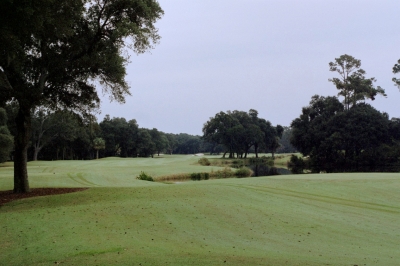 |
| A tree to the left of the tee box on the par five 9th hole -- and a pond to the right of the landing area -- strongly discourages a fade for your ball flight. |
It bugged him to the point where, when the new ownership at Kiawah Island Resort contacted him in 1995 to gauge his interest in redesigning Marsh Point, he gladly did it for free.
How’s that for anxiously accepting an offered mulligan?
Ric Ferguson, Cougar Point’s Head Golf Professional, echoed Freeland’s account: “The original design of this golf course was much more ‘target golf’ – the fairways were very narrow, there were sharp drop-offs to the water hazards, and the greens were very undulating. Back at the time they were originally designed, greens speeds weren’t nearly as fast, and it wasn’t a very long course that required accuracy. As the greens speeds increased over the years, Marsh Point became a course that was difficult for average players to even shoot their handicaps.”
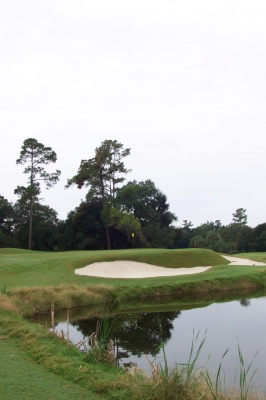 |
| The 443-yard, par four 10th hole is Cougar Point's #2 handicap hole -- and you can see by the green, you're going to pay dearly if you fail to hit the target. |
Because of the obvious playability issues, the number of rounds on Marsh Point declined in comparison to Kiawah’s other courses, Turtle Point, Osprey Point and the Ocean Course – all of which saw steady increases over the same time period. Marsh Point became the course you’d play only if the tee sheets at the others were completely full.
Bill Goodwin bought the resort in 1993, and decided that the situation on the ugly duckling golf course couldn’t remain – that’s when he contacted a very enthusiastic Gary Player about coming back to do the work.
The result of the collaboration was a brand new golf course, with only the routing remaining the same – that couldn’t be changed, because the residential neighborhood surrounding the layout was already fully developed.
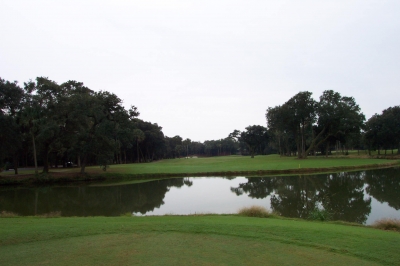 |
| It's only a mild carry from the back sets of tees on the 18th hole, but you'll still be glad when you're over it. |
“Tree-line to tree-line, tee to green, the golf course was completely new,” Ferguson said. “We moved water hazards around, eliminated all forced carries from the white and forward tees – there are really only two forced carries of any length remaining on the entire course, and they’re both from the blue and gold tees. There’s a new irrigation system, new yardages for the tees, including a shorter ‘short’ set, and a lengthened back set (to 6,875 yards), much more user-friendly. It looked completely different than the old days, and everybody was proud of that.”
To basically ‘blow-up’ the old course, Marsh Point was shut down just after Thanksgiving in 1995, and it re-opened as Cougar Point the following September. Everyone involved agreed that the ‘new’ course needed a new name, the ‘Marsh Point’ moniker carrying too many negative associations with it. A contest was held, inviting interested people to submit new possibilities. Ferguson said they chose ‘Cougar’ because it continued the naming scheme of animals that are (or were, in the case of cougars) indigenous to the island, and because a lot of folks had suggested that name.
That’s not to say the entire baby was thrown out with the bathwater. Though the ‘new’ Cougar Point looked and felt new, it retained much of what was good before, namely the variety built into the original routing.
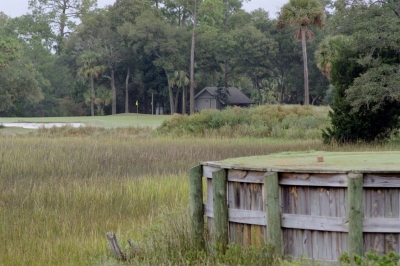 |
| Looking towards the tee box on the par three 6th hole. There's a lot of marsh between you and the green -- and probably a few thousand golf balls as well. |
“Marsh Point had its good points, namely the way it was originally laid out, with left-to-right, right-to-left type holes, so you don’t see a preference of directions or shots,” Ferguson said. “But Player took that good routing and put a lot of subtle movement into the fairways on the re-design. Obviously, since we’re on the coast, we don’t have a lot of elevation variations. But because of the mounding and contouring of the course, you’ll still get different types of lies. The mounding also helps to hide some things, like cart paths crossing the fairway on a couple holes.”
The course’s low-profile reminded us of some layouts we’ve seen on or around Hilton Head Island – and the same thing can be said of the relative closeness of the houses on the fairways, probably Cougar Point’s biggest drawback. But another aspect helped distinguish it from its resort siblings and other low-country courses in the region: its flashy bunkering.
“We wanted to raise up the faces on the bunkering, so when you stand on the tee or in the fairway, it gives the impression that there’s a ton of sand out there, but there’s really not,” Freeland explained. “If you look backwards on the hole, you’ll just see stands of grass. And the bunkers really aren’t that big – we just splashed the sand to visually intimidate the player. It’s also positioned in a way that it’s more visual and aesthetic than strategic, because it won’t really come into play if you’re hitting it reasonably straight.”
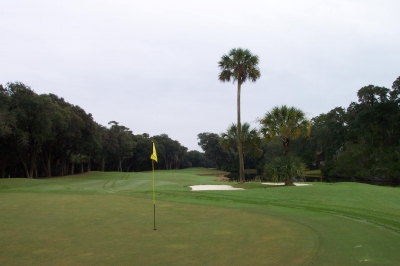 |
| From behind the flagstick of the par three 12th hole -- the houses aren't far away from you, but this view proves you can still find quiet solitude at Cougar Point. |
It’s a way of making the course look hard but play easy, which was more in line with the real Gary Player design philosophy. There were other things done during the renovation to make the course seem ‘bigger’ than its somewhat narrow corridors would allow.
Again, Freeland supplies the answers: “Bulk-heading was another tactic we used to make the course, or the playing areas, appear large enough to inspire some confidence in players. It’s a way of adding width, so you don’t have the lake banks to deal with -- which makes some of the tighter holes feel a little wider. Some of those holes were just too narrow, and the bulk-heading helped alleviate that.”
Another concern of the designers was the ample live oaks that the land had grown over the years, which contributed much of the cramped feeling of the layout. The property’s covenants protected the trees, so they had to find a way to work with or around them.
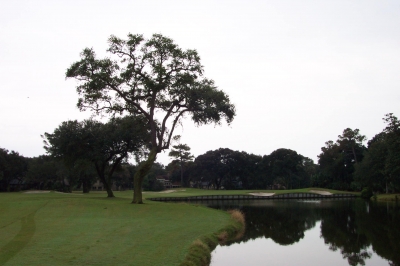 |
| Two large oak trees dictate your options on the par five 15th hole. You'll need to push your second shot past them if you're to have a clear view of the green. |
“Those oaks were so big that it took some extra consideration on some holes to see how they’d fit into the overall framework that we were trying to accomplish – because they’re protected, and also because we didn’t want to touch them anyway. They add a lot of character to the course, give it a mature look, and are very beautiful,” Freeland added.
One other note before looking at a few of the highlight holes – for you movie buffs, you might recognize Cougar Point as the ‘set’ for several scenes in ‘The Legend of Bagger Vance.’ The starter filled us in on that – particularly the scene at the beginning where Jack Lemmon has his heart attack – that’s the 11th hole at Cougar Point. You’ll certainly see it in the ‘flashy’ bunkering.
Highlights at Cougar Point include a stretch of holes midway through the outward nine, four, five and six, which play alongside the Kiawah River. For a layout that begins in the heart of the resort and surrounding community, these holes present a completely different flavor, with long-range vista views of endless marsh.
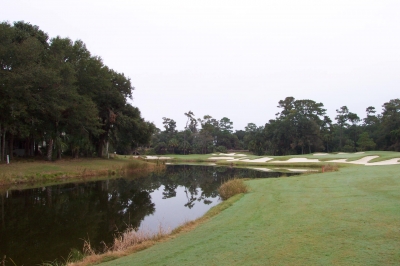 |
| The par five 3rd hole is a great risk-reward hole. |
Four and five are parallel long par fours playing in opposite directions – both either toughened or eased by the direction of the wind blowing off the marsh. Six is a very intimidating par three from the back sets of tees, as the green looks a lot farther away than its 180-yard length would indicate. As usual, once you’ve landed safely you’ll realize there was a lot of room out there all along.
On the back nine, the fifteenth hole is a terrific par five. Ferguson describes it: “Fifteen is tough on the first-time player, because on the second shot, you’ve got to get it past two big oak trees on the right side (there actually used to be a third cluster) – they’re ranging from 120 to 175 yards out. If you hit a big tee shot, you can try and go at the green and avoid the potential oak trouble, altogether. But those oaks really add to the hole, and Jim Kelechi (who is currently Osprey Point’s head pro, but was at Cougar during the renovation) fought hard to keep those two big trees, so you have to think on your second shot, or try to go over the water to reach the green in a risk-reward way. I think that’s good design.”
The eighteenth hole is a nice finishing hole, a challenging 415-yarder with a very memorable green – there’s a large bowl in the center. Needless to say, if the pin’s tucked down there and you can manage to roll it into the bowl, you could have a very nice birdie putt to close out the round.
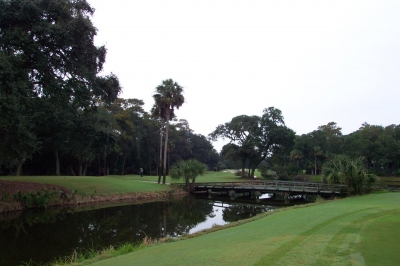 |
| With tees and greens close to each other and a beautiful low-country landscape, Cougar Point is a walking player's delight. |
Despite its considerable attributes, Ferguson says Cougar Point still doesn’t receive the play that the other Kiawah Resort courses get (in fairness, Cougar’s clubhouse isn’t in the same league as Osprey’s or Turtle’s) – but its reputation is gaining fast. Most people’s reactions are very positive, as were ours. Cougar plays easier than the other courses, and its compact nature makes it a very walk-able, enjoyable course.
It’s one ‘mulligan’ that turned out much better than the original shot. But don’t take that as a sign that yours will find the same kind of success. And besides, for you and me, it’s cheating.
Note: Check the links below for reviews of the other courses at Kiawah Island Golf Resort, as well as a preview of the accommodations.
Details:
Cougar Point at
Phone: (843) 768-2121
FAX: (843) 768-6093
Website: www.kiawahgolf.com
The Sanctuary's Website: www.thesanctuary.com
Course Designer: Gary Player (Tim Freeland was Project Architect, and Jim Kelechi added quite a lot of input)
Director of Golf: Roger Warren, PGA
Head Golf Professional: Ric Ferguson, PGA
Superintendent: Brad French
Tees/Yardage/Slope/Rating
Gold 6875 138/74.0
Blue 6523 127/71.6
White 6090 123/69.8
Green 5604 116/67.4 126/71.6 (L)
Red 4776 118/67.6
Rates:
Package rates for
The Championship Golf Package
Enjoy your choice of accommodations — in a luxurious oceanview guest room at The Sanctuary or in a one-bedroom scenic villa — plus one round on the world-renowned Ocean Course and two rounds at any of the resort’s other championship courses. Green fees, cart fees, range balls, daily breakfast and dinner at any resort restaurant are also included.
Sanctuary Championship Golf Package Rates
(Per person, per night for two people staying in an oceanview room. Single rates available.)
March 9 – May 31 . . . . . . . . . . . . From $540
June 1 – September 6 . . . . . . . . . From $468
September 7 – November 29 . . . . .From $529
November 29 – February 7, 2006 . .From $393
Villa Championship Golf Package Rates
(Per person, per night for two people staying in a one-bedroom scenic villa. Single rates available.)
March 9 – May 31 . . . . . . . . . . . . From $429
June 1 – September 6 . . . . . . . . . From $383
September 7 – November 29 . . . . From $423
November 29 – February 7, 2006 . .From $303
The Classic Golf Package
Enjoy your choice of accommodations — in a luxurious oceanview guest room at The Sanctuary or in a one-bedroom scenic villa — and one golf round per night's stay at any of the following four championship golf courses: Osprey Point,Turtle Point, Cougar Point and Oak Point. Green fees, cart fees, range balls and daily breakfast are also included.
Sanctuary Classic Golf Package Rates
(Per person, per night for two people staying in an oceanview room. Single rates available.)
March 9 – May 31 . . . . . . . . . . . . From $395
June 1 – September 6 . . . . . . . . . From $328
September 7 – November 29 . . . . .From $362
November 29 – February 7, 2006 . .From $260
Villa Classic Golf Package Rates
(Per person, per night for two people staying in a one-bedroom scenic villa. Single rates available.)
March 9 – May 31 . . . . . . . . . . . . .From $261
June 1 – September 6 . . . . . . . . . .From $241
September 7 – November 29. . . . . .From $254
November 29 - February 7, 2006. . .From $169
For additional information or to make reservations, call or click: 800.654.2924 • www.kiawahresort.com. For groups of 12 or more, call our group golf specialist: 800.576.1585.
| Related Links | Comments on this article? | |
|
Maryland National Golf Club Hollow Creek Golf Club Rocky Gap Resort PB Dye Golf Club in Ijamsville Whiskey Creek Golf Club |
E-mail Jeff Rendall, Editor: jrendall@golftheunitedstates.com |












